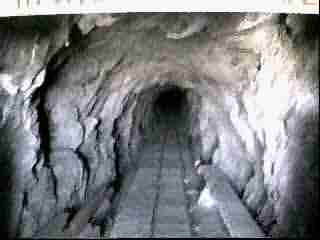
A strange but true story of perseverance

Our main reason for coming here on a cool March, 1999 weekend was to see and walk through one of the weirdest engineering projects imaginable: a tunnel which took 38 years to build yet leads nowhere.
William Henry "Burro" Schmidt, an enterprising miner who started operations around the turn of the century, decided he needed a better route than the circuitous and treacherous Last Chance Canyon to get his ore from Copper Basin to the nearby mill at Koehn Dry Lake in the valley below. His decision: dig a tunnel right through the mountain!
He built a cabin at one side of the basin. It is still there, full of
and surrounded by junk. (He was as bad a pack-rat as I am!)
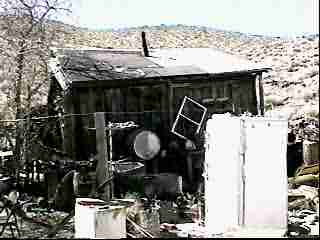
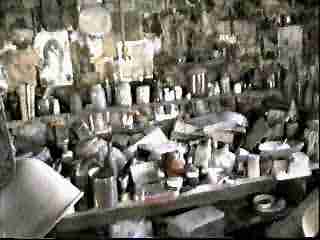
Vintage food boxes and magazines line the inside of the cabin, ostensibly
for insulation from the cold winters.
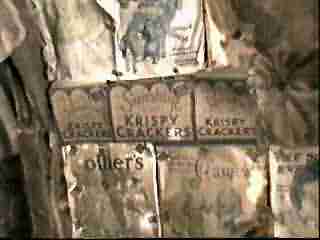
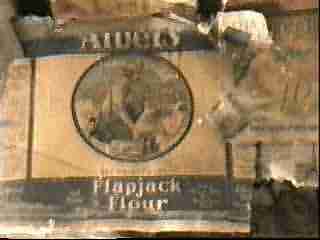
Beside the cabin is a larger house, occupied by the charismatic Tonie Seger. She is hard of sight and hearing but that doesn't stop her from talking! She kept us entertained for a couple of hours talking about everything BUT the Burro Schmidt story. Here she was explaining about her solar panels for electricity and her ornamental trees, which stand up very nicely to the desert conditions. She also talked about her "neigbors" (actually several miles away), showed us her whiskey bottle collection and talked about other aspects of desert life. There are a few people who live in trailers near her place who go into town and bring her supplies. It's hard to imagine someone as gregarious as Toni living in an isolated area like this, but she gets plenty of visitors to keep her company.

The front of Toni's house

When Toni was younger she made it a point to walk through the tunnel, about 1/4 mile away, once every day. She cleaned out any fallen rocks or debris to keep the tunnel looking much as it did the day Burro completed it. Someone else is now doing that job and the tunnel still looks great!
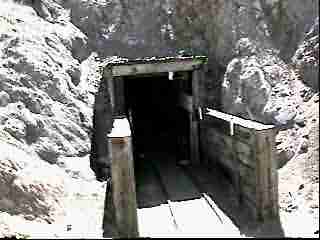
One day in 1906, accompanied by his burros Jack and Jenny, from the point shown above, Burro began digging through the solid granite mountain. Not with jackhammers and dynamite, mind you, but with hand-drills, picks and hammers. He did use a little dynamite, but it was such a precious commodity that he could only use it for the hardest areas.
Just a few years later, railroad construction brought better roads to the area, but Burro was undaunted. He had already invested about 4 years in this endeavour, and was not about to go away and leave it dead-ended! For the next 28 years he continued to hack away at the massive mountain, and 2087 feet and 5800 TONS of rock later he was greeted by this sight:

Koehn Dry Lake, far below. He had most likely planned a road down to the dry lake below, but as his new tunnel's utility had been superseded decades before, he called it quits.
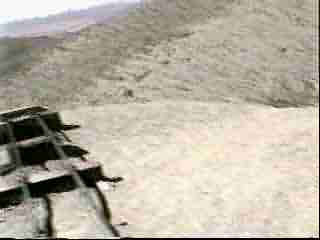
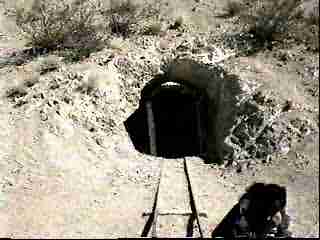
A trail leads up and over the mountain. It could have been used by Burro to survey his tunnel's progress. Now it is used by people who made it through but are too chicken to go back through again.
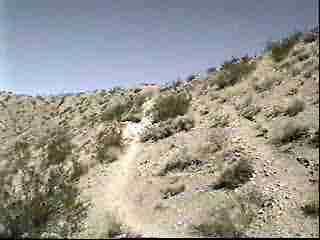
Some of Toni's hand-lettered signs:
This one on a metal door about 300 feet into the mountain:

It's hard to read in the light but... "The tunnel behind this door extends back about 35 feet. It is being used to store maintainance [sic] materials for the tunnel, including the vehicle used to keep the floor free of rocks and debris. The tracks have been restored and the vehicle now operates well."
A warning that mining in the tunnel is dangerous and prohibited. People have been tempted, as there is a legend (what desert story is complete without a legend?) that Burro found a fantastic vein of gold ore in the tunnel but blocked it up and hid it to keep it a secret. (In reality, the tunnel walls are intact all the way through, and it would be extremely difficult to hide anything there.)
The red reflector one sees when reaching the end of the main adit. The tunnel does not make a straight shot through the mountain; rather, it terminates in a "T". To the right is the other end of the tunnel, and to the left is a rather peculiar tunnel that gets smaller, takes a 90 degree turn, and finally ends. Burro most likely decided to do some mining to see if he could make his lifelong project pay off somehow.

In the end, Burro moved away, never to see the Copper Basin area again. But his name will forever grace this place which bears an eternal monument to his lifelong obsession.
Here are some of the other interesting things we saw on our journey through this area:
A shack next to a mine in a small, rugged canyon

Inside the shack - a table and fireplace
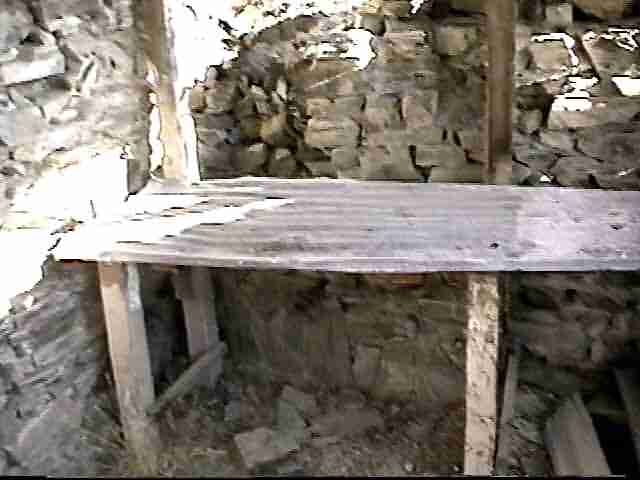

The mine entrance, which reminded me of an alien monster's mouth..
We ventured inside - it went in about 200 feet, dog-legged to the left,
went another 300 feet and terminated in a "T". We saw remnants of electrical
and ventilation systems.
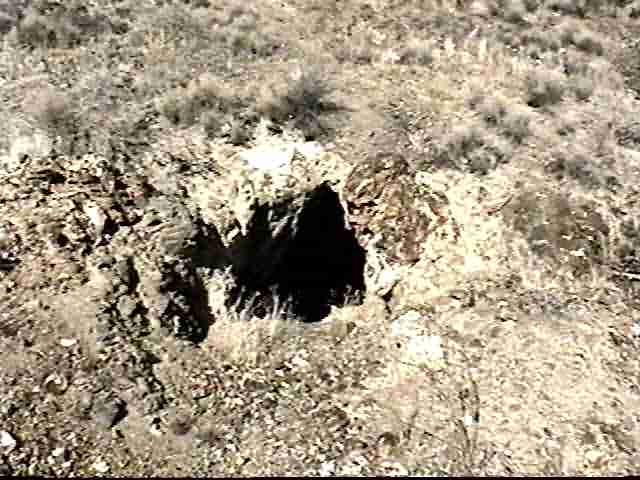

In the upper Copper Basin area we found what was once a nice house.
I mentioned the name "Della Gerbracht" to Toni and she said they were not
particularly friendly people.There was still a lot of junk around the house,
and it was pretty well shot up by uncaring gun fanatics.
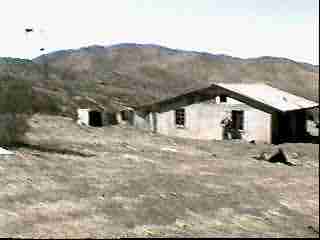
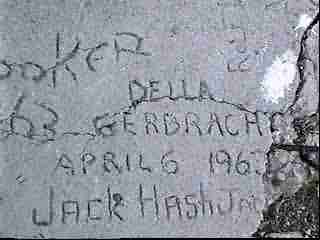

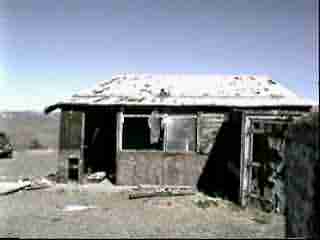
We descended into Last Chance Canyon


Then we found a fun little road up and off to the side and couldn't
resist the challenge. We ended up at a spectacular overview near an old
gypsum mine.
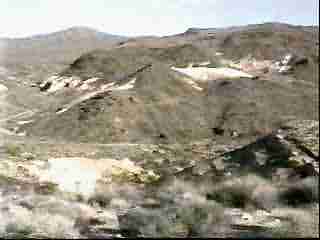

Ever wonder where your wallboard comes from? This is the most massive underground mine I've seen yet. It consists of a series of digs by some obviously massive machine through the vein of gypsum, which is tilted about 30 degrees from horizontal.The miners left behind just enough material in giant pillarlike formations to keep the whole thing from collapsing.


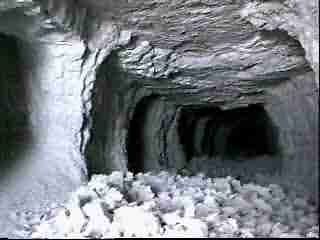
We set up camp in a somewhat rugged valley about 5 miles away.

A small cross atop a nearby hill
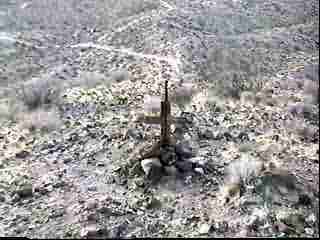
We tooled around a while the next day before heading home. Fascinating geology abounds

A small mine, dug in at an angle, about 20 feet deep
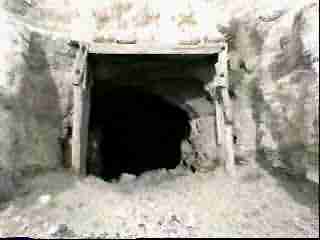
A sign pointing to Barrett's Opal Mine, an area where you can pay about $2 to hack away at rocks looking for beautiful opals

We descended into an unbelievable valley. (I'll post more pics of this place when I get a chance.) On one side is a moonscape badlands leading down to Last Chance Canyon. On the other side are more badlands, and on the west side is a spectacular bluff. The pics I have now are of the road out (WILD!)


Thus concluded our tour of the Red Rock Canyon area.
Accessed
times since 4/28/00